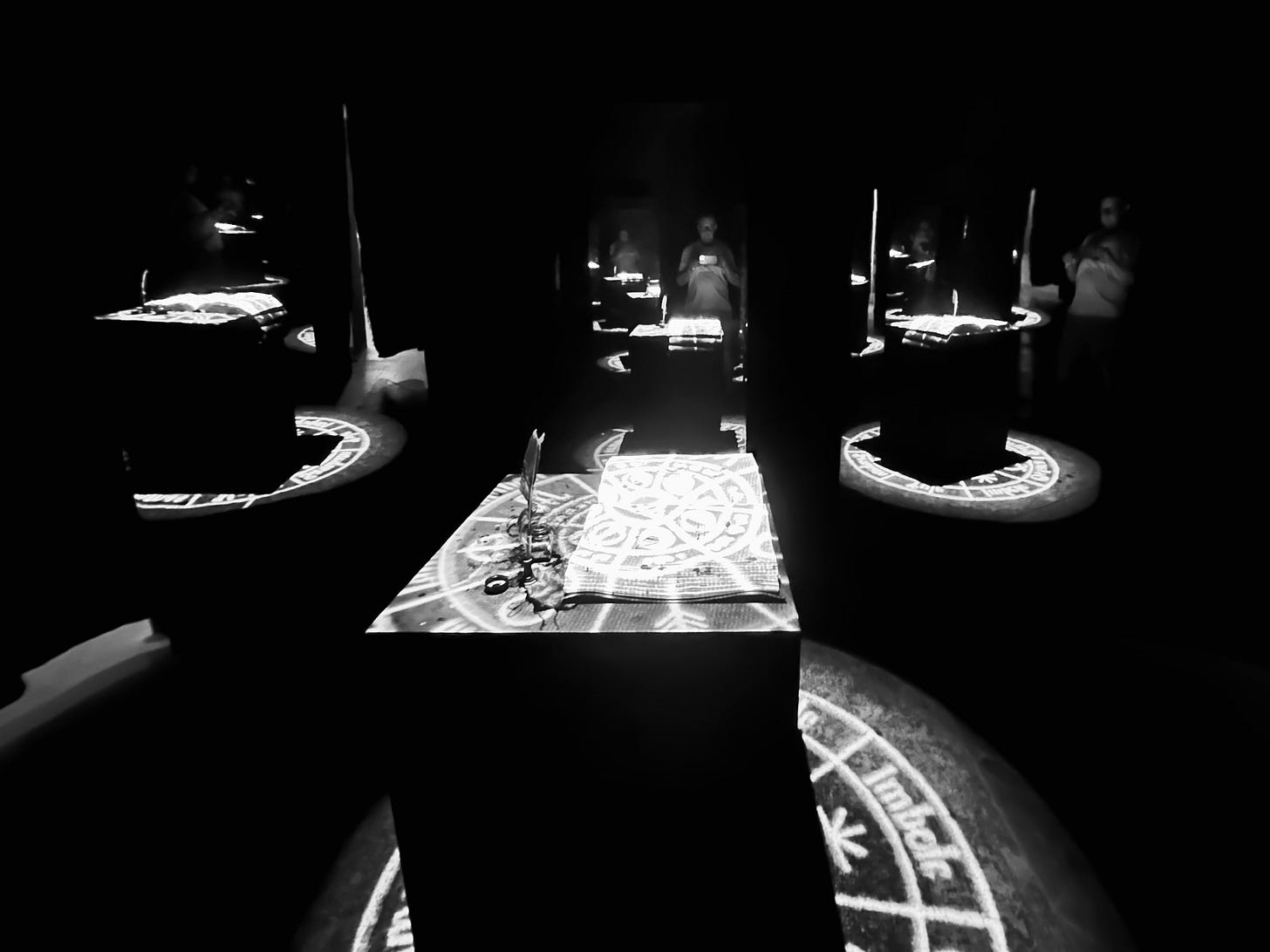
Back
Like Jeffrey Streeter, who’s recently written about ‘returns’, I’ve returned from a long holiday – four weeks travelling through Belgium, Germany, Austria and Italy, with longer stops at Verona – where I had that fall – Lake Iseo, Bologna and Elba, then home through France. We had a great time although the weather was very mixed. You can find a record of the many different patches of sky under which we travelled in my Notes.
The mirror in the text
If you’ve followed the stream of my posts so far, you’ll know I’m fascinated by the concept and the manifestations of mise en abîme, or mise en abyme as preferred by the English translators of Lucien Dällenbach, who wrote Le récit speculaire, the definitive work on the subject so far. I’ll standardise on mise en abyme as that seems to be the English language preference.
In his book, translated as The mirror in the text,1 Dällenbach quotes André Gide’s original 1893 text where he refers to mise en abyme for the first time:
In a work of art, I rather like to find thus transposed, at the level of the characters, the subject of the work itself. Nothing sheds more light on the work or displays the proportions of the whole work more accurately. Thus, in paintings by Memling or Quentin Metzys, a small dark convex mirror reflects, in its turn, the interior of the room in which the action of the painting takes place. Thus, in a slightly different way, in Velasquez's Las Meniñas. Finally, in literature, there is the scene in which a play is acted in Hamlet; this also happens in many other plays. In Wilbelm Meister, there are the puppet shows and the festivities in the castle. In The Fall of the House of Usher, there is the piece that is read to Roderick etc. None of these examples is absolutely accurate. What would be more accurate, and what would explain better what I'd wanted to do in my Cahiers, in Narcisse and in La Tentative, would be a comparison with the device from heraldry that involves putting a second representation of the original shield.2
Dällenbach goes on to write:
…the term mise en abyme is used unproblematically by authors to group together a collection of distinct things. As in Gide, these can be reduced to three essential figures:
(a) simple duplication (a sequence which is connected by similarity to the work that encloses it);
(b) infinite duplication (a sequence which is connected by similarity to the work that encloses it and which itself includes a sequence that ... etc.); and
(c) aporetic duplication (a sequence that is supposed to enclose the work that encloses it).
The emblematic and unifying use of the mirror by numerous critics is explained by the fact that these three duplications can each, in a way, be related to one or other aspect of mirror re-flexion.
Although I understand Dällenbach’s strict definition, for my personal use, I’ve expanded the concept to include notions of being inserted or interspersed into a reflexive or recursive depth, being interlocked or enmeshed in it, or enclosed and immersed by it. For me, it’s as much about the abyme as the mise.
I think my extension of the conceptual space is justified by Dällenbach’s comments when he writes:
Not that a linguistic work cannot summarize itself; but to enclose the summary of this summary, and, within this, the summary of the summary of the summary, is incompatible with the constraints of linearity that govern it. Even if it were not, these successive summaries, alternately interrupted and resumed, would exceed the reader's patience and rememorative competence: since the regenerative power of memory is limited, the degree of embedding must also be; and even if it were not, how could it create an impression of vertigo by presenting itself successively? Only instantaneity of representation can provide a compelling and truly vertiginous effect.
In expanding the conceptual space there are more opportunities for this ‘instantaneity of representation’ with its ‘compelling and truly vertiginous effect.’
A hidden city in a city
Nowhere did this strike me more than when we visited Mantua, the day after my fall and a night in hospital. The scale and complexity of the Palazzo Ducale is simply astonishing, comparable in its own way with Versailles.
‘If we penetrate the Palace, we are struck by a sense of wonder, a theatrical surprise,’ wrote Guido Piovene in 1957, quoted on the wall of a stairwell in the complex. ‘It is, in Mantua, another hidden city. The Palazzo suggests the fantasy of the labyrinth and the interplay of mirrors.’
And for me the high point was to be inside the Camera degli Sposi. The images of the ruling family, the artist’s cunningly inserted, concealed image of himself, and the the unexpected circular opening painted in the centre of the vaulted ceiling and revealing the patch of sky above, struck me with that ‘compelling and truly vertiginous effect’ – the emotional force of the punctum.
Enfilades of sumptuous rooms
Not surprisingly, in view of what I was to discover there, as soon as I entered the Palace complex through the archway to the Castello di San Giorgio, I felt myself drawn again into the territory of the mise en abyme. The place is astonishing. ‘You can wander at length through those enfilades of sumptuous rooms,’ adds Piovene, ‘discover small brilliant apartments ...’


As the illustrated guide3 tells us, ‘Of the many surprises of the Palazzo Ducale, the Camera degli Sposi (the Bride and Bridegroom's Room) - or rather the Camera Picta (the Painted Room) as it was called in the old documents - is one of the most spectacular.’ The walls of La camera degli Sposi are filled with frescoes. A small plaque on the west wall tells us they were completed in 1474 by ‘Andrea Mantinia Patavus’, Andrea Mantegna from Padua, dedicated to his patron Marquis Ludovico II Gonzaga and his wife Barbara of Brandenburg.
The guide continues that the ‘work was carried out in two quite distinct stages. First of all the room itself was rebuilt… then, presumably from 1471 onwards, the pictorial decoration was executed by Mantegna at a leisurely pace, employing precious paints and materials such as gold and lapis lazuli.’
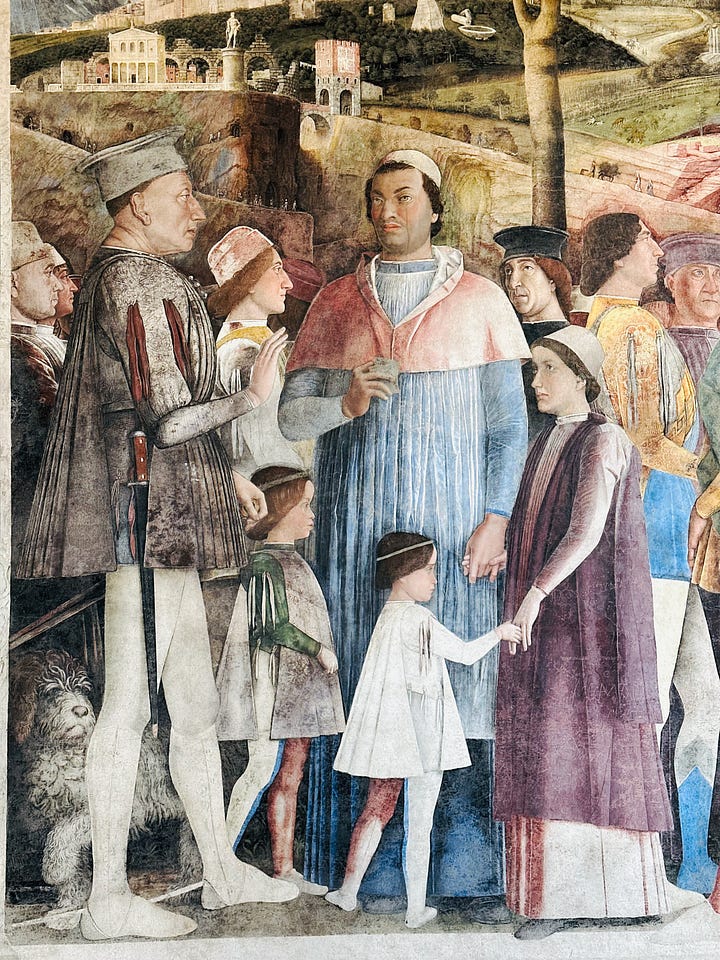

The guide highlights that it was ‘Mantegna himself who gave a new meaning to the concept of Camera Picta by painting the most coherent, complex and innovative secular decorative cycle of the fifteenth century, creating a virtual "room in a room"… With an extraordinary taste for illusion and the audacious use of perspective and light, Mantegna completely changes our perception of space and the consistency of materials. The walls become damask curtains supported by richly ornamented pilasters, the painting on the ceiling simulates the relief of stuccowork, a garland of fruit and foliage surrounds the vault and the lunettes, the open sky appears in the upper parts of the walls and in the oculus a cloud takes on a human profile.’
In other words, this is mise en abyme through majestic trompe l’oeil.
‘The ambiguity, the contradictions and anachronisms which are abundantly present are all the more surprising because they form part of scenes that seem to be perfectly realistic. In effect, Mantegna combines two apparently conflicting objectives: on the one hand he gives a detailed description of important figures and historical events relating to the rule of Ludovico II Gonzaga, while on the other he celebrates the splendour of the Mantuan court in a symbolic fashion, offering a public image of it that has withstood the passage of time, together with the canonical heraldic trappings. It is only by interpreting the decorative cycle on these two planes, one anchored to reality and the other outside the temporal dimension, that it is possible to explain the decorative scheme created by Mantegna and understand why its execution took such a long time…In the Camera degli Sposi everything is in a delicate equilibrium between concrete reality and fantastic illusion.’
As if to remind us of its importance, Mantegna keeps a patch of sky over the room. in the centre of the vault, there is the unexpected circular opening giving onto the sky above, with putti, animals and ladies leaning out over the parapet with vertiginous foreshortening.
Miching malicho!
One example of mise en abyme examined in Dallenbach’s book is the play within a play in Shakespeare’s Hamlet,4 although he ultimately rejects it as a true example by his definition. But it provides a wonderful concatenation in my own.
Hamlet plans that the play the actors perform before the court will provoke his uncle, the king, to reveal his guilt and culpability in the death of Hamlet’s father. Watching the play, the King now married to Hamlet’s mother, asks
King. What do you call the play?
Note that the King asks, What do you call the play, not this play? In that question it seems to me, Shakespeare is highlighting the nature of reflexivity and recursiveness inherent in art, nesting a drama within the flow of everyday life, the theatrical space inserted into and surrounded by the platform of life and living.
Hamlet replies:
Ham. The Mousetrap – marry, how tropically! This play is the image of a murder done in Vienna– Gonzago is the Duke’s name, his wife Baptista–you shall see anon. ‘Tis a knavish piece of work.
‘Marry, how tropically!’ puns on ‘trapically’ and on the ‘exclamation of derision when a man was successfully tricked or discomforted. Cf Wiv i.i.151, ‘I will say “marry trap” with you’, i.e. I will get my own back on you.’
This all is intimately connected with reflexivity and Shakespeare seems to me to be showing us that reflexivity is a kind of trap where we can be caught into a mise en abyme of constant recursiveness.
In fact, the play within a play is entitled The Murder of Gonzago. It is no coincidence that this is so similar to the name of the Mantuan dynasty, the Gonzaga.
In Act III Scene 2, where Hamlet provides Ophelia with a commentary on the play within a play, like the commentator on a puppet show, he describes the murder victim:
Ham. His name’s Gonzago. The story is extant, and written in very choice Italian. You shall see anon how the murderer gets the love of Gonzago’s wife.
The supposed source of this reference to an ‘extant story’ has never been found.
Preceding the play within a play, there’s a dumb-show, or mime, an intricacy which itself reflects the play within a play.
Oph. What means this, my lord?
Ham. Marry, this is miching malicho. It means mischief.
Oph. Belike this show imports the argument of the play.
This miching malicho is ‘sneaking mischief’ an apt description of mise en abyme.
So there’s a triple reflection involved – the dumbshow, reflecting the play within a play, and the play within the play reflecting the diegesis of the play.
But as Simon Critchely and Jamieson Webster point out in their book The Hamlet Doctrine5, ‘Hamlet ends with Horatio making good on his promise to tell Hamlet’s story…Like The Mousetrap, then, The Tragical Historie of Hamlet, Prince of Denmarke is a play within a play, the truth of which will be told by Horatio in a further play acted before Fortinbras, the English ambassadors, and the muddied multitude of Denmark. We might want to call it Hamlet II. The difference this time,’ the authors add, ‘is that all the actors will be dead’. So, it seems to me, they will be revivified as puppets, and the play as puppetry – perhaps one further piece of ‘sneaky mischief’ from Shakespeare, playing all the while with the ambivalence and ambiguities between art and ‘real’ life, which after all, takes place in reflecting and reflexive brains, mise en abyme.
And when Ophelia says to Hamlet,
Oph. You are naught. You are naught.
For me it calls to mind the O of the ouroboros that eats its own tail, a very common image for mise en abyme, as Dällenbach remarks.
The play’s the thing
The play within a play is ‘the thing wherein I hope to catch the conscience of the king’. Note that wherein, not by which. The ‘wherein’ suggests enclosure, the trap of reflection, that the king’s conscience will reflect on his guilt.
Of course, The Mousetrap is also the name of the famous play by Agatha Christie that has been running on the London stage for over 70 years, the world’s longest running play. The play began life as radio play Three Blind Mice based on the death of an abused boy in foster care. Christie then turned it into the stage play and then a short story.
No film version of the play can be made until the stage run has been finished for at least six months. However, as the Wikipedia entry on The Mousetrap tells it, in another twist of the ouroboros’ mise en abyme tail, ‘After unsuccessfully attempting to acquire the film rights to the play, Damian Jones was inspired to produce a film more loosely based on the play. Jones' idea became the 2022 film See How They Run, a murder mystery which takes place at the West End production of The Mousetrap in 1953, in which the murder victim is a director who has been hired to direct a film adaptation of the play.’
Multiple mise en abyme
So after our holiday, I find myself wonderfully mise en abyme in multiple reflections across time and space: from the Gonzaga family in Mantua and the city within a city, to The Murder of Gonzago play within a play within a play within a play in Hamlet, from Shakespeare’s ‘miching malicho’ to a film producer’s film about the murder of the director hired to make a film of The Mousetrap, the longest running stage play in the world, and then back to Mantua, and the ‘room in a room’, the Painted Room where the artist Mantegna created many of the murals.
In the decorative border of one wall, the face of the painter looks out from the design — winsomely, ironically, thoughtfully — putting himself mise en abyme in his own painting. For the painter has painted himself looking back at himself, a kind of selfie, but now looking at us too. He appears happy to be so mise en abyme, and rightly so, for his masterpiece of both domestic and political decoration that has lasted 500 years. That beats the run of The Mousetrap by centuries.
Thank you for stopping by this patch of sky. Another patch will be passing next Thursday when I’ll continue the strange interconnections at Mantua
Lucien Dällenbach, The mirror in the text, translated by Jeremy Whiteley (Cambridge: Polity Press, 1989)
From A. Gide, Journal 1889-1939 (Paris, Gallimard, Pléiade, 1948), p. 41, cf. Journals 1889-1949, translated by J. O'Brien (London, Penguin,1984), pp. 30-1
Stefano Zuffi, Mantegna - La Camera Degli Sposi (Milan: Electa S.p.A.,2015)
All references from Hamlet are from William Shakespeare, The Tragedy of Hamlet, Prince of Denmark, edited by Harold Jenkins (London, Thomas Nelson & Sons Ltd, 1997)
Simon Critchley & Jamieson Webster, The Hamlet Doctrine, (London: Verso, 2013) p.226


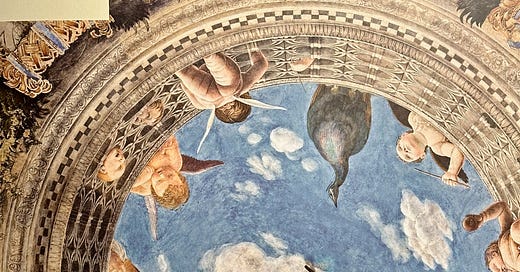



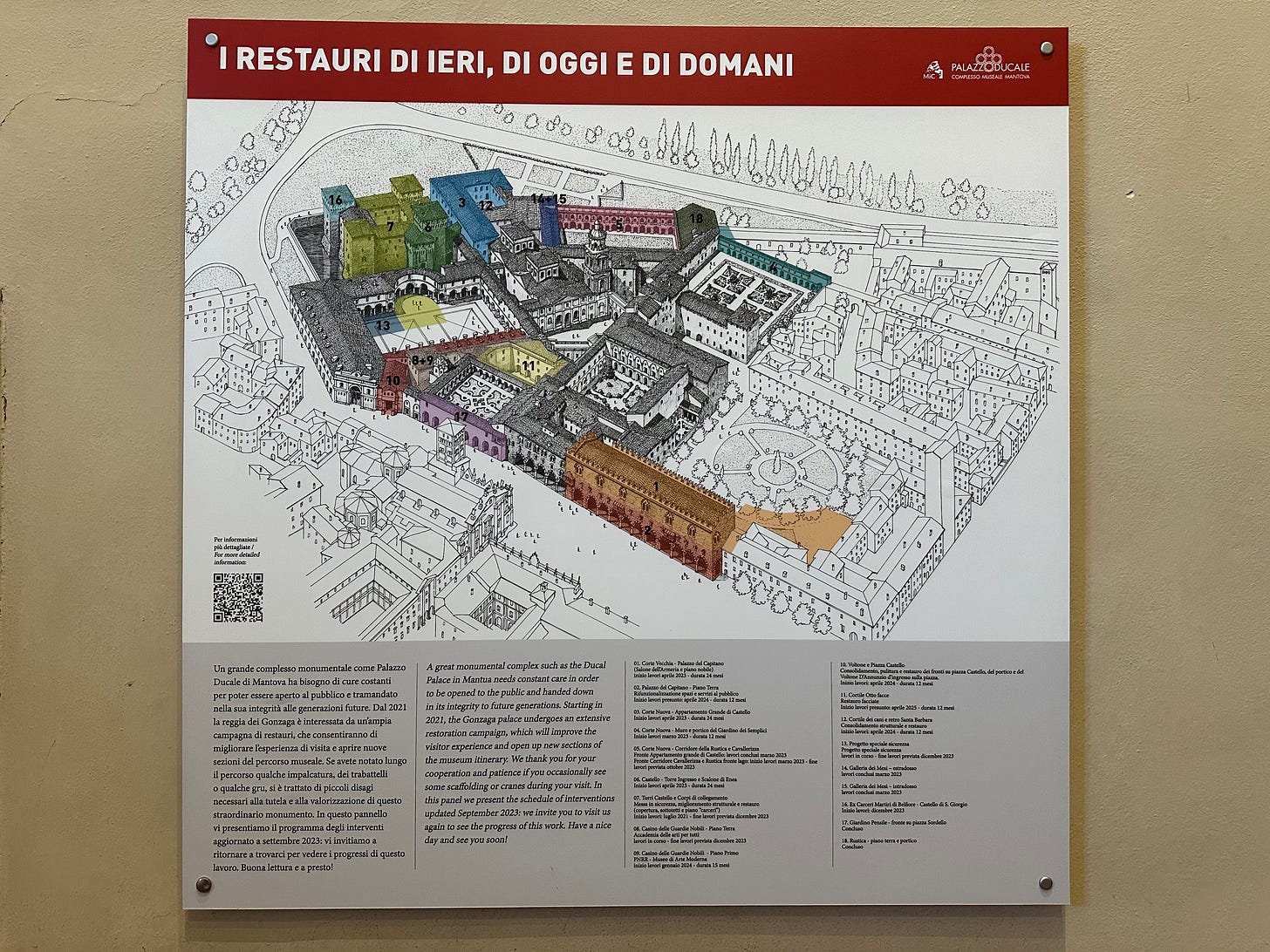

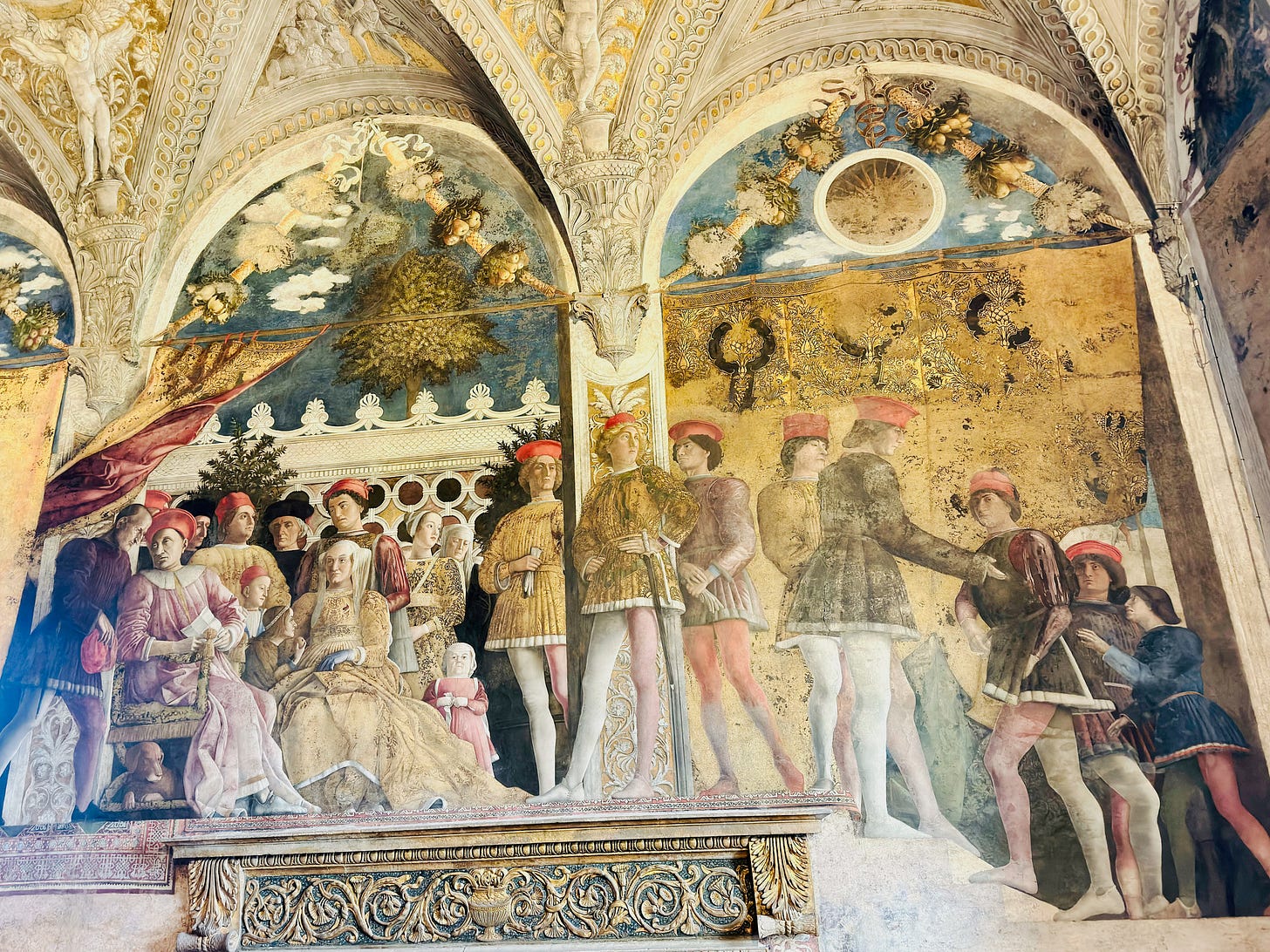
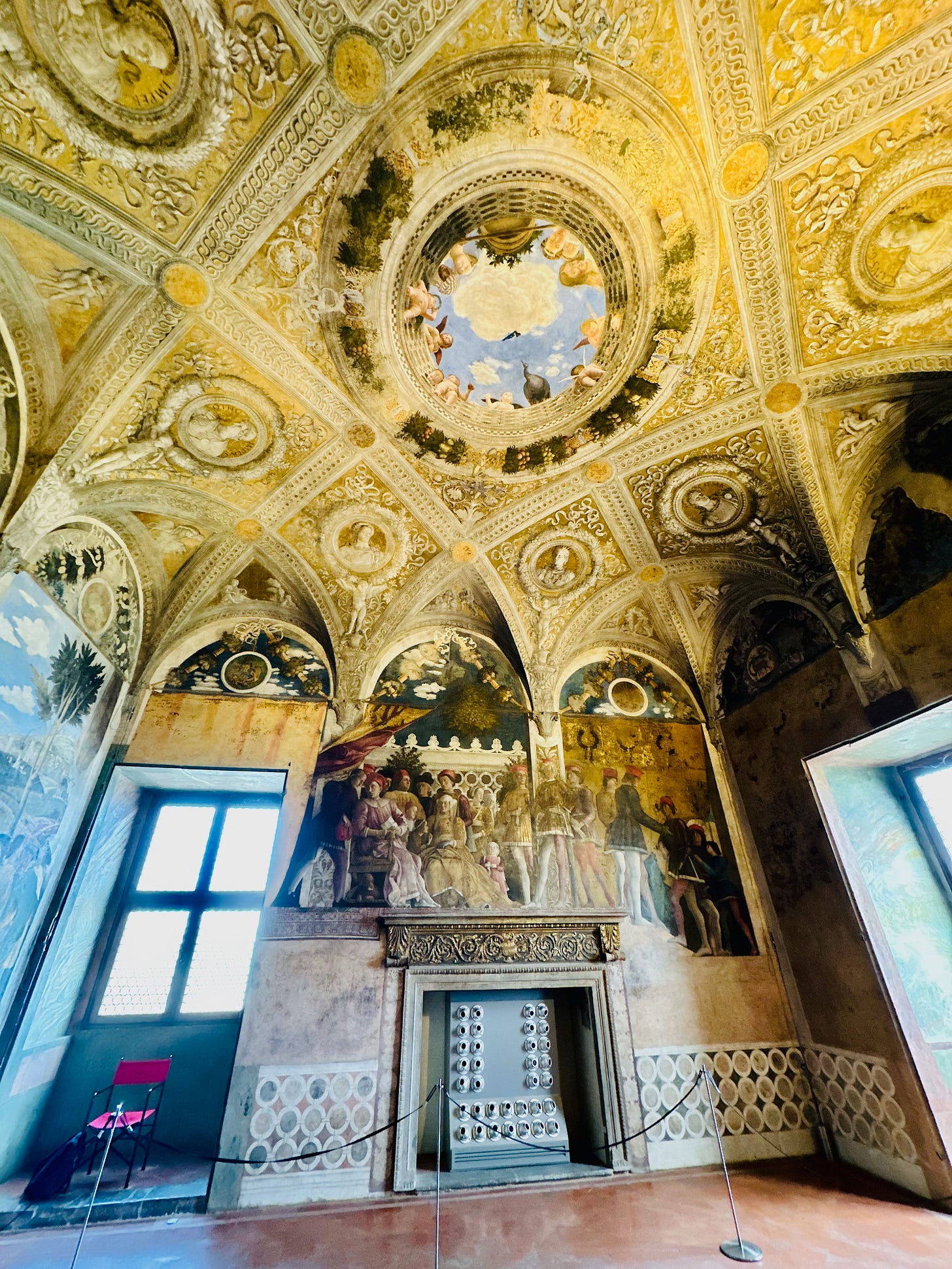

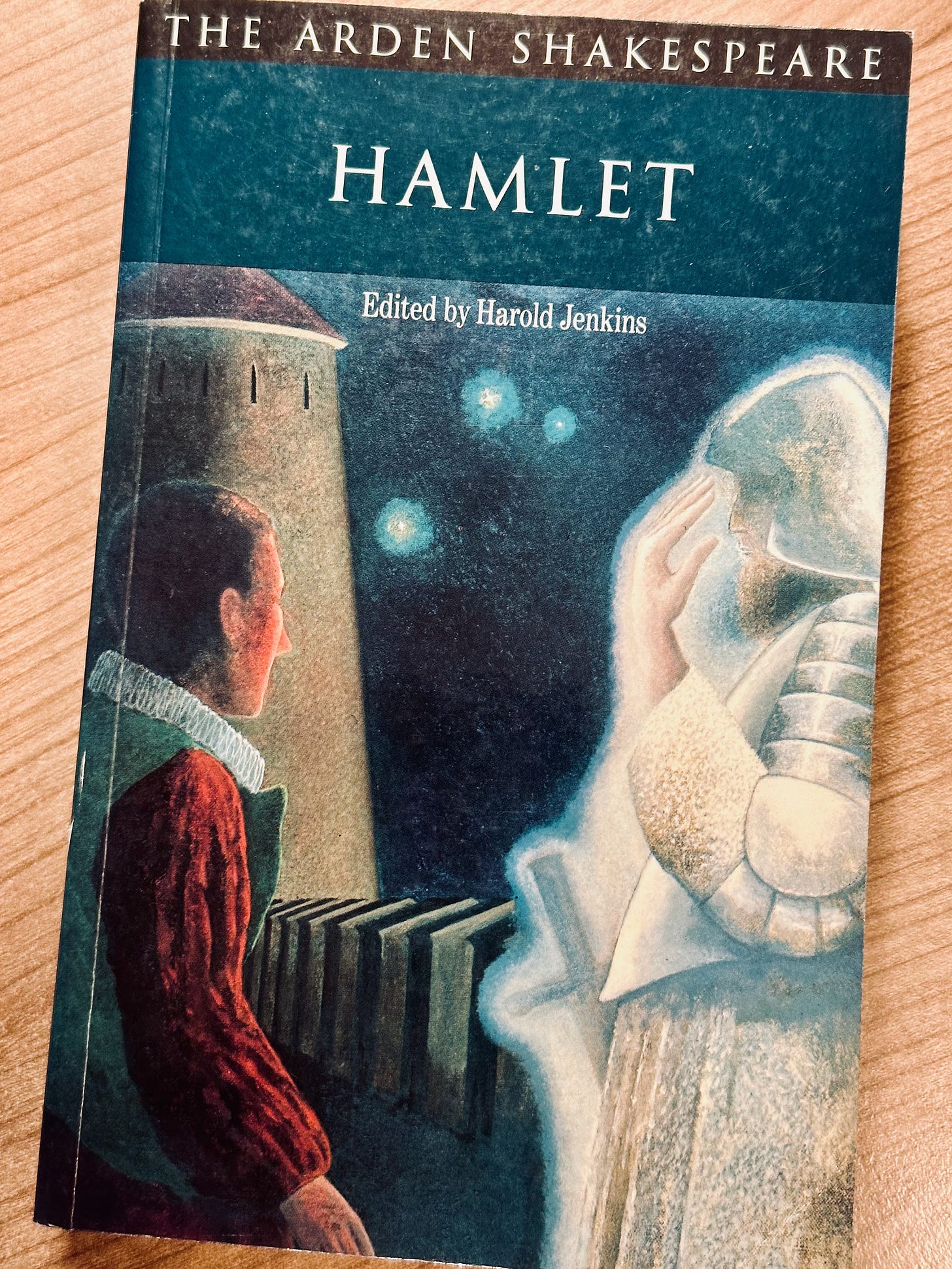



Intriguing.